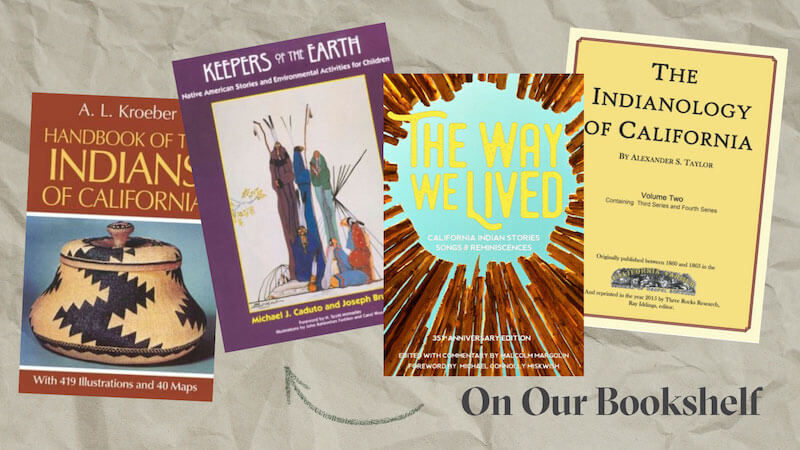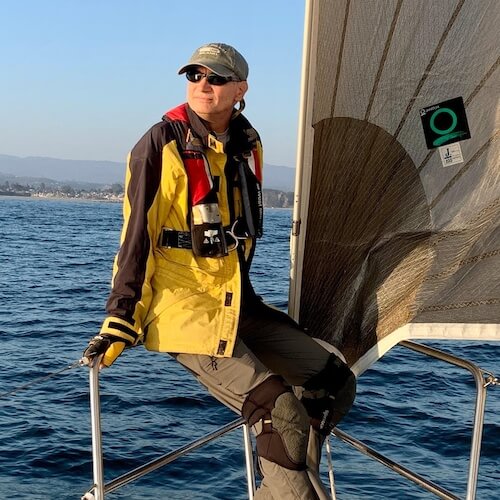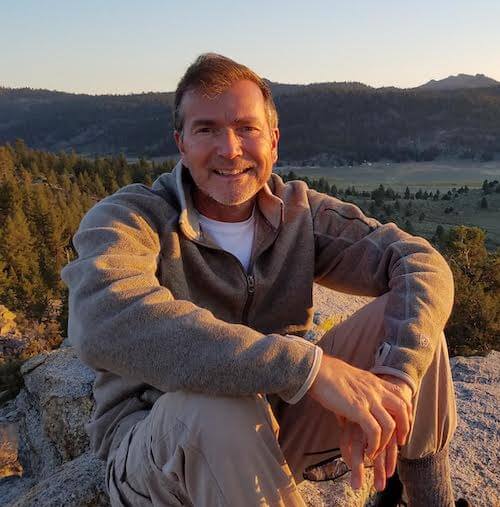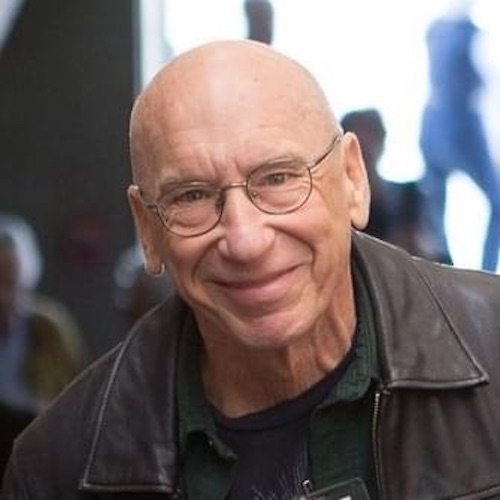
Supporting Indigenous people begins with honoring their history and recognizing their past — a true understanding of what was and is, not some rewritten and romanticized childhood history lesson. Without some knowledge of the extraordinary network of nations that populated these lands — their cultures, beliefs, customs, and languages and what happened to them — how could there ever be understanding? Without understanding, how could there be true connection? Or reparative support?
This month, we’re checking out a few titles suggested by the Esselen Tribe of Monterey County itself to learn about and appreciate these great peoples and their vibrant communities.
edited with commentary by Malcolm Margolin
This treasure trove filled with personal histories, prayers, death chants, dream journeys, speeches, coyote tales, and so much more was first published in 1981, and it remains a seminal record of the Indigenous peoples who lived on these lands since time immemorial. An ethnographic collection complete with first-person accounts of community, joy, and healing but also, sadly, of systemic massacres — a few of the many atrocities committed by white people and the US government. The poetry and imagery evoke heartbreaking vulnerabilities and realities, making this a must-read for all who live here on the ancestral land of Turtle Island.
by Michael J. Caduto and Joseph Bruchac
Ecologist, author, and storyteller Michael Caduto mixes environmentalism with Native American wisdom in this classic guide from 1988 to connect young people to the natural world and teach them how to tend to our precious life-giving planet. Stories of Native American history and spirituality are coupled with hands-on environmental activities for a combo that all parents, aunties, uncles, friends, and grandparents can share with the little ones in their life. For those who want even more, this book is only the first in a series that includes Keepers of the Animals and Keepers of Life, focusing on the fauna and flora, respectively.
by A. L. Kroeber
“This book is the outcome of 17 years of acquaintance and occupation with the Indians of California…Although it may seem otherwise, it attempts to be a history,” writes A. L. Kroeber in his preface. This survey, published in 1925, is the cultural anthropologist’s attempt to record all the facts and figures he could concerning individual tribes. With 479 illustrations and 40 maps, covering demographic situations, linguistics, social structures, folkways, religion, and material culture, this is a valuable resource for historians and anthropologists by an incredibly dedicated chronicler of life. (Though he was probably extremely progressive for his time, readers should prepare themselves for the writer’s Post-World War I language.) Some of the tables (e.g., “Yuman song cycles” and “Principal dances and ceremonies of the Kuksu system of the central tribes”) and specific illustrations may contain details hard to find anywhere else.
by Alexander Smith Taylor
Considered the "first bibliographer of California," Taylor wrote for The California Farmer and Journal of Useful Arts; this compiled reprint of 151 articles originally published between 1860 and 1863 is the culmination of that work. Through personal research and interviews with Native Americans, the author reported on the history, languages, and customs of many native peoples of California, along with some vocabulary and linguistic materials. Again, keep in mind that these pieces were written over one hundred and sixty years ago, so don’t expect a style that’s all that, well, accessible. The book is, however, a repository of knowledge that might otherwise be lost to history; plus, as a slice of the mid-19th century, the writing itself is an anthropological artifact to learn from.

“Remembering to be as self compassionate as I can and praying to the divine that we're all a part of.”
–Aaron
“Prayer, reading, meditation, walking.”
–Karen
“Erratically — which is an ongoing stream of practice to find peace.”
–Charles
“Try on a daily basis to be kind to myself and to realize that making mistakes is a part of the human condition. Learning from our mistakes is a journey. But it starts with compassion and caring. First for oneself.”
–Steve
“Physically: aerobic exercise, volleyball, ice hockey, cycling, sailing. Emotionally: unfortunately I have to work to ‘not care’ about people or situations which may end painfully. Along the lines of ‘attachment is the source of suffering’, so best to avoid it or limit its scope. Sad though because it could also be the source of great joy. Is it worth the risk?“
–Rainer


“It's time for my heart to be nurtured on one level yet contained on another. To go easy on me and to allow my feelings to be validated, not judged harshly. On the other hand, to let the heart rule with equanimity and not lead the mind and body around like a master.”
–Suzanne
“I spend time thinking of everything I am grateful for, and I try to develop my ability to express compassion for myself and others without reservation. I take time to do the things I need to do to keep myself healthy and happy. This includes taking experiential workshops, fostering relationships, and participating within groups which have a similar interest to become a more compassionate and fulfilled being.“
–Peter


“Self-forgiveness for my own judgments. And oh yeah, coming to Esalen.”
–David B.
“Hmm, this is a tough one! I guess I take care of my heart through fostering relationships with people I feel connected to. Spending quality time with them (whether we're on the phone, through messages/letters, on Zoom, or in-person). Being there for them, listening to them, sharing what's going on with me, my struggles and my successes... like we do in the Esalen weekly Friends of Esalen Zoom sessions!”
–Lori

“I remind myself in many ways of the fact that " Love is all there is!" LOVE is the prize and this one precious life is the stage we get to learn our lessons. I get out into nature, hike, camp, river kayak, fly fish, garden, I create, I dance (not enough!), and I remain grateful for each day, each breath, each moment. Being in the moment, awake, and remembering the gift of life and my feeling of gratitude for all of creation.”
–Steven
“My physical heart by limiting stress and eating a heart-healthy diet. My emotional heart by staying in love with the world and by knowing that all disappointment and loss will pass.“
–David Z.
Today, September 29, is World Heart Day. Strike up a conversation with your own heart and as you feel comfortable, encourage others to do the same. As part of our own transformations and self-care, we sometimes ask for others to illuminate and enliven our hearts or speak our love language.
What if we could do this for ourselves too, even if just for today… or to start a heart practice, forever?
Steven Gutierrez is an editor, writer, and ghostwriter. He has worked in book publishing and at several major (and some minor) magazines.

Supporting Indigenous people begins with honoring their history and recognizing their past — a true understanding of what was and is, not some rewritten and romanticized childhood history lesson. Without some knowledge of the extraordinary network of nations that populated these lands — their cultures, beliefs, customs, and languages and what happened to them — how could there ever be understanding? Without understanding, how could there be true connection? Or reparative support?
This month, we’re checking out a few titles suggested by the Esselen Tribe of Monterey County itself to learn about and appreciate these great peoples and their vibrant communities.
edited with commentary by Malcolm Margolin
This treasure trove filled with personal histories, prayers, death chants, dream journeys, speeches, coyote tales, and so much more was first published in 1981, and it remains a seminal record of the Indigenous peoples who lived on these lands since time immemorial. An ethnographic collection complete with first-person accounts of community, joy, and healing but also, sadly, of systemic massacres — a few of the many atrocities committed by white people and the US government. The poetry and imagery evoke heartbreaking vulnerabilities and realities, making this a must-read for all who live here on the ancestral land of Turtle Island.
by Michael J. Caduto and Joseph Bruchac
Ecologist, author, and storyteller Michael Caduto mixes environmentalism with Native American wisdom in this classic guide from 1988 to connect young people to the natural world and teach them how to tend to our precious life-giving planet. Stories of Native American history and spirituality are coupled with hands-on environmental activities for a combo that all parents, aunties, uncles, friends, and grandparents can share with the little ones in their life. For those who want even more, this book is only the first in a series that includes Keepers of the Animals and Keepers of Life, focusing on the fauna and flora, respectively.
by A. L. Kroeber
“This book is the outcome of 17 years of acquaintance and occupation with the Indians of California…Although it may seem otherwise, it attempts to be a history,” writes A. L. Kroeber in his preface. This survey, published in 1925, is the cultural anthropologist’s attempt to record all the facts and figures he could concerning individual tribes. With 479 illustrations and 40 maps, covering demographic situations, linguistics, social structures, folkways, religion, and material culture, this is a valuable resource for historians and anthropologists by an incredibly dedicated chronicler of life. (Though he was probably extremely progressive for his time, readers should prepare themselves for the writer’s Post-World War I language.) Some of the tables (e.g., “Yuman song cycles” and “Principal dances and ceremonies of the Kuksu system of the central tribes”) and specific illustrations may contain details hard to find anywhere else.
by Alexander Smith Taylor
Considered the "first bibliographer of California," Taylor wrote for The California Farmer and Journal of Useful Arts; this compiled reprint of 151 articles originally published between 1860 and 1863 is the culmination of that work. Through personal research and interviews with Native Americans, the author reported on the history, languages, and customs of many native peoples of California, along with some vocabulary and linguistic materials. Again, keep in mind that these pieces were written over one hundred and sixty years ago, so don’t expect a style that’s all that, well, accessible. The book is, however, a repository of knowledge that might otherwise be lost to history; plus, as a slice of the mid-19th century, the writing itself is an anthropological artifact to learn from.

“Remembering to be as self compassionate as I can and praying to the divine that we're all a part of.”
–Aaron
“Prayer, reading, meditation, walking.”
–Karen
“Erratically — which is an ongoing stream of practice to find peace.”
–Charles
“Try on a daily basis to be kind to myself and to realize that making mistakes is a part of the human condition. Learning from our mistakes is a journey. But it starts with compassion and caring. First for oneself.”
–Steve
“Physically: aerobic exercise, volleyball, ice hockey, cycling, sailing. Emotionally: unfortunately I have to work to ‘not care’ about people or situations which may end painfully. Along the lines of ‘attachment is the source of suffering’, so best to avoid it or limit its scope. Sad though because it could also be the source of great joy. Is it worth the risk?“
–Rainer


“It's time for my heart to be nurtured on one level yet contained on another. To go easy on me and to allow my feelings to be validated, not judged harshly. On the other hand, to let the heart rule with equanimity and not lead the mind and body around like a master.”
–Suzanne
“I spend time thinking of everything I am grateful for, and I try to develop my ability to express compassion for myself and others without reservation. I take time to do the things I need to do to keep myself healthy and happy. This includes taking experiential workshops, fostering relationships, and participating within groups which have a similar interest to become a more compassionate and fulfilled being.“
–Peter


“Self-forgiveness for my own judgments. And oh yeah, coming to Esalen.”
–David B.
“Hmm, this is a tough one! I guess I take care of my heart through fostering relationships with people I feel connected to. Spending quality time with them (whether we're on the phone, through messages/letters, on Zoom, or in-person). Being there for them, listening to them, sharing what's going on with me, my struggles and my successes... like we do in the Esalen weekly Friends of Esalen Zoom sessions!”
–Lori

“I remind myself in many ways of the fact that " Love is all there is!" LOVE is the prize and this one precious life is the stage we get to learn our lessons. I get out into nature, hike, camp, river kayak, fly fish, garden, I create, I dance (not enough!), and I remain grateful for each day, each breath, each moment. Being in the moment, awake, and remembering the gift of life and my feeling of gratitude for all of creation.”
–Steven
“My physical heart by limiting stress and eating a heart-healthy diet. My emotional heart by staying in love with the world and by knowing that all disappointment and loss will pass.“
–David Z.
Today, September 29, is World Heart Day. Strike up a conversation with your own heart and as you feel comfortable, encourage others to do the same. As part of our own transformations and self-care, we sometimes ask for others to illuminate and enliven our hearts or speak our love language.
What if we could do this for ourselves too, even if just for today… or to start a heart practice, forever?

Supporting Indigenous people begins with honoring their history and recognizing their past — a true understanding of what was and is, not some rewritten and romanticized childhood history lesson. Without some knowledge of the extraordinary network of nations that populated these lands — their cultures, beliefs, customs, and languages and what happened to them — how could there ever be understanding? Without understanding, how could there be true connection? Or reparative support?
This month, we’re checking out a few titles suggested by the Esselen Tribe of Monterey County itself to learn about and appreciate these great peoples and their vibrant communities.
edited with commentary by Malcolm Margolin
This treasure trove filled with personal histories, prayers, death chants, dream journeys, speeches, coyote tales, and so much more was first published in 1981, and it remains a seminal record of the Indigenous peoples who lived on these lands since time immemorial. An ethnographic collection complete with first-person accounts of community, joy, and healing but also, sadly, of systemic massacres — a few of the many atrocities committed by white people and the US government. The poetry and imagery evoke heartbreaking vulnerabilities and realities, making this a must-read for all who live here on the ancestral land of Turtle Island.
by Michael J. Caduto and Joseph Bruchac
Ecologist, author, and storyteller Michael Caduto mixes environmentalism with Native American wisdom in this classic guide from 1988 to connect young people to the natural world and teach them how to tend to our precious life-giving planet. Stories of Native American history and spirituality are coupled with hands-on environmental activities for a combo that all parents, aunties, uncles, friends, and grandparents can share with the little ones in their life. For those who want even more, this book is only the first in a series that includes Keepers of the Animals and Keepers of Life, focusing on the fauna and flora, respectively.
by A. L. Kroeber
“This book is the outcome of 17 years of acquaintance and occupation with the Indians of California…Although it may seem otherwise, it attempts to be a history,” writes A. L. Kroeber in his preface. This survey, published in 1925, is the cultural anthropologist’s attempt to record all the facts and figures he could concerning individual tribes. With 479 illustrations and 40 maps, covering demographic situations, linguistics, social structures, folkways, religion, and material culture, this is a valuable resource for historians and anthropologists by an incredibly dedicated chronicler of life. (Though he was probably extremely progressive for his time, readers should prepare themselves for the writer’s Post-World War I language.) Some of the tables (e.g., “Yuman song cycles” and “Principal dances and ceremonies of the Kuksu system of the central tribes”) and specific illustrations may contain details hard to find anywhere else.
by Alexander Smith Taylor
Considered the "first bibliographer of California," Taylor wrote for The California Farmer and Journal of Useful Arts; this compiled reprint of 151 articles originally published between 1860 and 1863 is the culmination of that work. Through personal research and interviews with Native Americans, the author reported on the history, languages, and customs of many native peoples of California, along with some vocabulary and linguistic materials. Again, keep in mind that these pieces were written over one hundred and sixty years ago, so don’t expect a style that’s all that, well, accessible. The book is, however, a repository of knowledge that might otherwise be lost to history; plus, as a slice of the mid-19th century, the writing itself is an anthropological artifact to learn from.

“Remembering to be as self compassionate as I can and praying to the divine that we're all a part of.”
–Aaron
“Prayer, reading, meditation, walking.”
–Karen
“Erratically — which is an ongoing stream of practice to find peace.”
–Charles
“Try on a daily basis to be kind to myself and to realize that making mistakes is a part of the human condition. Learning from our mistakes is a journey. But it starts with compassion and caring. First for oneself.”
–Steve
“Physically: aerobic exercise, volleyball, ice hockey, cycling, sailing. Emotionally: unfortunately I have to work to ‘not care’ about people or situations which may end painfully. Along the lines of ‘attachment is the source of suffering’, so best to avoid it or limit its scope. Sad though because it could also be the source of great joy. Is it worth the risk?“
–Rainer


“It's time for my heart to be nurtured on one level yet contained on another. To go easy on me and to allow my feelings to be validated, not judged harshly. On the other hand, to let the heart rule with equanimity and not lead the mind and body around like a master.”
–Suzanne
“I spend time thinking of everything I am grateful for, and I try to develop my ability to express compassion for myself and others without reservation. I take time to do the things I need to do to keep myself healthy and happy. This includes taking experiential workshops, fostering relationships, and participating within groups which have a similar interest to become a more compassionate and fulfilled being.“
–Peter


“Self-forgiveness for my own judgments. And oh yeah, coming to Esalen.”
–David B.
“Hmm, this is a tough one! I guess I take care of my heart through fostering relationships with people I feel connected to. Spending quality time with them (whether we're on the phone, through messages/letters, on Zoom, or in-person). Being there for them, listening to them, sharing what's going on with me, my struggles and my successes... like we do in the Esalen weekly Friends of Esalen Zoom sessions!”
–Lori

“I remind myself in many ways of the fact that " Love is all there is!" LOVE is the prize and this one precious life is the stage we get to learn our lessons. I get out into nature, hike, camp, river kayak, fly fish, garden, I create, I dance (not enough!), and I remain grateful for each day, each breath, each moment. Being in the moment, awake, and remembering the gift of life and my feeling of gratitude for all of creation.”
–Steven
“My physical heart by limiting stress and eating a heart-healthy diet. My emotional heart by staying in love with the world and by knowing that all disappointment and loss will pass.“
–David Z.
Today, September 29, is World Heart Day. Strike up a conversation with your own heart and as you feel comfortable, encourage others to do the same. As part of our own transformations and self-care, we sometimes ask for others to illuminate and enliven our hearts or speak our love language.
What if we could do this for ourselves too, even if just for today… or to start a heart practice, forever?
Steven Gutierrez is an editor, writer, and ghostwriter. He has worked in book publishing and at several major (and some minor) magazines.